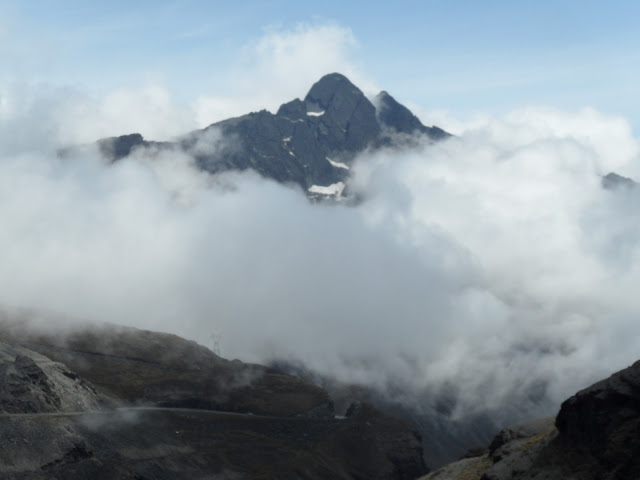
On November,12 I arrive in La Paz and enter the city nestled in the bottom of a bowl shaped valley. Then navigate the maze-like city streets and find the Casa de Ciclistas (house of cyclists) where I would meet many others from around the world traveling by bike. I have come up with a small list of things do to while in La Paz, it seems like a good place to rest and explore the surrounding mountains. The first couple days I spend exploring the city and doing some research on the places I plan to visit. One of the things on my list was to ride the camino de la muerte "the death road", which is marketed to tourists as the 'most dangerous road in the world'. There must be more dangerous roads out there but this one has claimed a lot of deaths from the narrow road with over hanging cliff walls. With a Columbian and Belgian from the casa we entered the road from the top of La Cumbre pass and rode down into the heavy clouds where it started to rain, due to cloud cover we could not see the cliffs edge and valley below as we continued down the road, so it seemed just like any other dirt road until the clouds cleared, and when they did it was clear why it was named the death road.
 |
| camino de la muerte |
Next on the list was to visit Tiahuanaco/Tiwanaku, the important Pre-Columbian archeological site which lies in a valley 76km outside of La Paz. Andean scholars believe that it once flourished as an important regional power in the southern Andes for at least 500 hundred years however they left no written history so there is much speculation regarding the religious and administrative life of this community. I was lucky to have a guide who did his best to explain the significance of this archeological wonder.
 |
| Tiwanaku guide and shaman apprentice |
After climbing Huanya Potosi (see previous post) I stayed in La Paz for a few more days before riding out of the city to the brow of El Alto and continued south to Oruro. One of my last days in the city happened to be the 'national census day', this takes place every ten years and is the occasion for counting the citizens of the country. No one is allowed to leave their residence for 24 hours while they go from house to house counting the population. This includes foreigners as well so we decided to make a party out of it and loaded up on food and drinks and enjoyed the surreal experience of being locked up as virtual prisoners for a day.
From La Paz it took me two days to reach Oruro and arrived on a Saturday night. I then found out that a train leaves twice weekly for Uyuni and one would leaving the following day, a Sunday afternoon, so I decided to save some time and ride the train. After an inexpiable 6 hour delay in the middle of the night the train arrived in Uyuni the following morning, Nov, 26.
 |
| climbing out of the city, with HP in background |
 |
| with Santiago, La Paz |
 |
| La Cumbre pass |
 |
| riding into the clouds below |
 |
| vision of the past |




 |
| remains of former pyramid |










 |
| Santiago(Argentina), Alejandro(Columbia), me, Carlos(Spain), Sylvain(France) |
|
 |
| leaving La Paz on the way to Oruro (Huanya Potosi in the background) |
 |
| El Alto with Huanya Potosi |
 |
| riding the new road - smooth, straight and no cars |
 |
| Oruro fiesta |
I then spent a couple of days in the outback town of Uyuni visiting the railroad cemetery and planing for my trek across the Salar de Uyuni and South toward the Bolvian border.
 |
| train cemetery - Oruro, Bolivia |
 |
| leaving La Paz |




















































